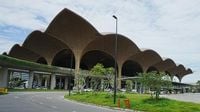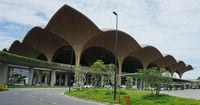Cambodia’s aviation landscape took a dramatic leap forward this week as Prime Minister Hun Manet officially inaugurated Techo International Airport, a sprawling new hub that promises to redefine travel, tourism, and investment opportunities for the nation. The inauguration, held on October 20, 2025, marked the culmination of years of planning and construction, and signals Cambodia’s ambitions to become a major player in Southeast Asian air travel.
Nestled in Kandal province, about 30 kilometers (19 miles) south of Phnom Penh, the $2 billion facility replaces the nearly 70-year-old Phnom Penh International Airport. The old airport, with its single runway, had long been the gateway to Cambodia’s capital, but its limited capacity and aging infrastructure could no longer keep pace with the country’s growing needs. Techo International Airport, by contrast, boasts three runways and a suite of modern amenities designed to handle the demands of a rapidly expanding tourism and business sector.
The new airport began operations in September 2025, but Monday’s inauguration was a moment of national pride, bringing together government officials, international partners, and business leaders. According to the Associated Press, the airport is a joint venture between the Cambodian government and the Overseas Cambodian Investment Corporation (OCIC), reflecting a blend of public ambition and private sector expertise. The project’s development was spearheaded by Cambodia Airport Investment Co. (CAIC), a subsidiary of OCIC, in partnership with the State Secretariat of Civil Aviation (SSCA).
International collaboration has been key to the airport’s creation and operation. France’s VINCI Airports, which began operating Techo International Airport on September 9, 2025, leads a global team that includes design and engineering support from Britain’s Foster + Partners, Atkins, Heerim Architects, and consultants from Singapore’s Changi Airport. Construction firms from Cambodia, France, and China all played a role in bringing the vision to life.
“Techo International Airport is a symbol of Cambodia’s progress and its growing role as a hub for travel, trade, and tourism in Southeast Asia,” said Pung Kheav Se, Chairman of CAIC and OCIC, as quoted by Asian Aviation. The airport’s design blends world-class functionality with authentic Cambodian heritage, featuring Khmer-inspired architectural elements, a striking 9-meter Abhayamudra Buddha statue, and more than 200 hand-carved stone sculptures by local artisans. The terminal’s aesthetic, crafted by Foster + Partners, is both a nod to tradition and a testament to modern sustainability, with energy-efficient practices integrated throughout.
Operationally, Techo International Airport is already making its mark. It currently hosts 31 airlines, offering 44 direct connection routes and handling approximately 13,500 passengers and 130 aircraft movements daily. The airport’s capacity is impressive: it is initially expected to accommodate 13 million passengers annually, with plans to increase to 30 million after 2030 and up to 50 million by 2050, according to the Associated Press. This scale positions Cambodia to absorb future tourism growth and business travel, ambitions the country’s leadership is keen to realize.
Prime Minister Hun Manet, during the inauguration, emphasized the airport’s strategic importance for Cambodia’s future, stating his hope that Techo International Airport would be a “driving force in attracting more tourists and investors to Cambodia, more than before the arrival of COVID-19.” This optimism is not unfounded. Cambodia received about 4 million foreign tourists from January through August 2025, and 6.7 million in 2024—a 23% increase from 2023—demonstrating a robust recovery from the pandemic’s impact on global travel.
The airport’s international reach is expanding rapidly. Since its opening, Etihad Airways has launched direct flights between Abu Dhabi and Phnom Penh, providing a vital link to the Middle East and Europe. Turkish Airlines is set to begin service to Istanbul in December 2025, while Air Cambodia, the national flag carrier, will start regular flights to Tokyo later this month. These new routes not only connect Cambodia to major global hubs but also enhance its appeal as a destination for business and leisure travelers alike.
For travelers arriving at Techo International Airport, the experience is intended to be more than just functional. “Techo International Airport will be the first warm welcome many visitors receive in Cambodia—reflecting our hospitality and culture,” said Minea Kim, Chief Executive Officer of the Cambodia Tourism Board, as reported by Asian Aviation. “Cambodia is committed to offering experiences that inspire and delight travellers.”
Behind the scenes, the airport’s operations are supported by SIA Engineering Company, a subsidiary of the Singapore Airlines Group, which provides maintenance, repair, and overhaul (MRO) services. This ensures that the airport’s high standards are maintained, and that both passengers and airlines benefit from reliable and efficient service.
Yet, the path to a tourism renaissance has not been without obstacles. The Associated Press notes that the immediate prospects for a surge in foreign visitors have been overshadowed by recent negative publicity, including the highly publicized death of a young South Korean man who was reportedly lured to Cambodia and forced to work in an online scam center. These centers, which have been the target of international sanctions and criminal indictments, cast a shadow over Cambodia’s efforts to present itself as a safe and welcoming destination.
Additionally, regional tensions have had an impact. In July 2025, Cambodia engaged in a five-day conflict with neighboring Thailand, which, despite being halted by a ceasefire, has left lingering concerns and affected tourism flows. Nevertheless, the government remains steadfast in its commitment to restoring Cambodia’s reputation and drawing visitors from around the world.
Techo International Airport is Cambodia’s second major new airport in just two years. In October 2023, the country opened Siem Reap-Angkor International Airport to serve the world-renowned Angkor Wat temple complex, underscoring a broader strategy to modernize national infrastructure and position Cambodia as a premier travel destination.
The airport’s opening comes amid a period of strong global aviation growth, especially in Asia. VINCI Airports, which operates Techo International Airport, reported welcoming 94 million passengers worldwide in the third quarter of 2025—a 4.2% year-on-year increase—driven by high load factors and increased airline seat supply. Connections between China and Japan, as well as regional markets like South Korea and Taiwan, have been particularly robust, with Cambodia benefiting from these trends through expanded regional connectivity.
As Cambodia looks to the future, Techo International Airport stands as both a practical solution to the country’s growing travel demands and a powerful symbol of its aspirations. With state-of-the-art facilities, world-class partnerships, and a deep respect for local culture and sustainability, the new airport is poised to be a cornerstone of Cambodia’s economic and social development for decades to come.

